The Snow Goose (Chen caerulescens) is a fairly large, white, or dark gray and white goose with black wingtips.
This common waterfowl species breeds in the Arctic and winters in wetlands and coastal habitats in the lower 48 states.
Watch for Snow Geese flocks during migration and in the winter. When present, these big, noisy black and white geese are unmistakable.
On this page
Identification
The Snow Goose is a medium to large waterfowl species with a pinkish beak and grayish-pink legs and feet. Both sexes look the same although males tend to be a bit bigger.
There are two main color morphs; mostly white birds, and dark birds known as the Blue Goose. White morph Snow Geese are brilliant white waterfowl with large black wingtips and some buff coloration on their heads.
Related: What does finding a white feather mean?
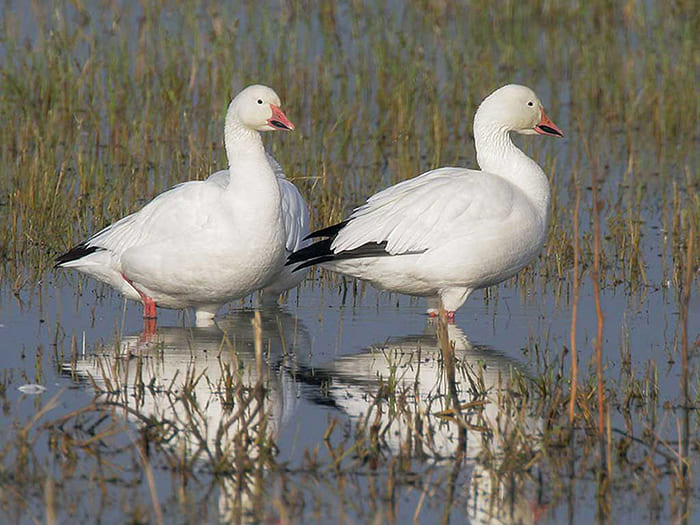
Photograph © Tom Grey. Note the black “grin patch” on the bill.
Dark morph Snow Geese are dark, blackish-gray birds with lighter gray highlights on their wings and belly. They have a white tail, undertail, and belly, and also have white under their wings, and on their head and neck.
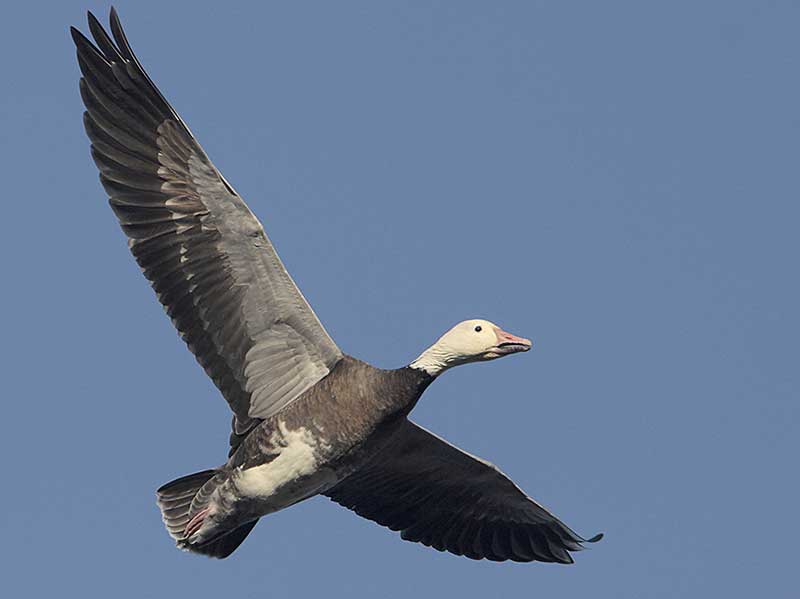
Snow goose, dark morph in flight
The Snow Goose also comes in two sizes. The Lesser Snow Goose is 28 inches long, has a 53 inch wingspan, and weighs 5.3 pounds, while the ”Greater” Snow Goose is 31 inches, has a wingspan of 56 inches, and weighs 7.4 pounds.
Adults also have a black area on their beaks that makes the bird look as if it were smiling.
Young birds are mostly dark gray or dingy white with gray highlights.
These hefty geese have long, broad wings that help them migrate long distances. They fly with deep flaps and glides, and also have a broad tail.
Snow Goose Call
We often hear flocks of Snow Geese before seeing them. They make hoarse, bark-like honking calls over and over.
Food
The Snow Goose feeds on tubers, grasses, leaves, and other bits of vegetation. During the breeding season, adults eat vegetation from sedges, willows, aquatic plants, and shrubs that grown in the tundra. Young birds also feed on fly larvae and some flowers, and berries.
In winter, this species follows a similar diet but eats more berries, grain, crops, and tubers.
Snow Geese do all of their foraging on the ground. They often wade in the shallow water of coastal marshes, waterlogged meadows, and other shallow wet habitats.
While standing and walking on the wet ground, they submerge their head below the water to pick and dig up roots, tubers, and other vegetation.
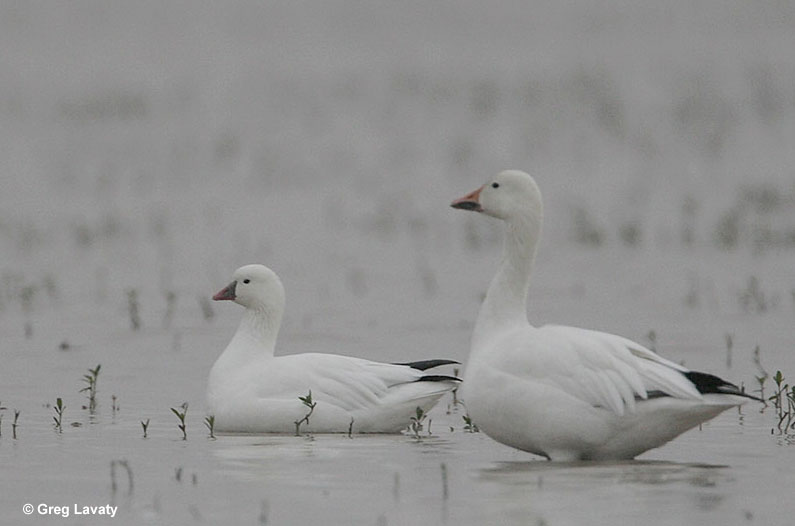
Snow Goose (the bigger bird) with a Ross’s Goose (the smaller bird)
They do similar foraging behaviors in wet meadows and in open grassy fields near water. In migration and winter, the Snow Goose also looks for food in farming areas.
These geese slowly walk through farm fields, looking for grain and other vegetation they can feed on. When they find food, they quickly pick it up from the ground, often staying in one spot to methodically eat as much of it as they can.
Snow Geese can eat several types of vegetation but tend to pick up wet vegetation and other food items that are easier to digest.
Nesting and Eggs
The female Snow Goose picks the nest site. She chooses a spot in the tundra, on dry ground near a rock or shrub. After she finds a suitable nesting site, the mother goose makes a shallow scrape on the ground.
She can line it with some down but often lays her eggs first and then adds feathers and other vegetation after. The female Snow Goose can lay her first egg as soon as she picks her nesting site and ends up laying two to six eggs total.
The eggs are creamy white, 3.1 inches long, and weigh 4.39 ounces. The second egg is usually bigger than the other eggs, and they hatch after a bit more than three weeks of incubation.
The female Snow Goose does all of the incubation, but the male can stand nearby while she sits on the eggs.
Just 24 hours after the eggs hatch, the goslings leave the nest to follow their mother around.
As the mother goose and young birds graze on vegetation and catch flying insects, their father keeps an eye out for predators. After 43 days, the young Snow Geese can fly but continue to stay near their parents until the start of the following breeding season.
Current Situation
The Snow Goose breeds in various parts of northern Arctic Canada, northwestern Greenland, and in parts of northeastern Siberia.
They migrate through much of North America and winter on the Atlantic Coast from Massachusetts to the Carolinas, in coastal Texas and other parts of the Gulf of Mexico, and in wetlands in the central and western USA. Snow Geese also winter in parts of Mexico.
This species breeds in Arctic tundra, and winters in shallow wetlands.
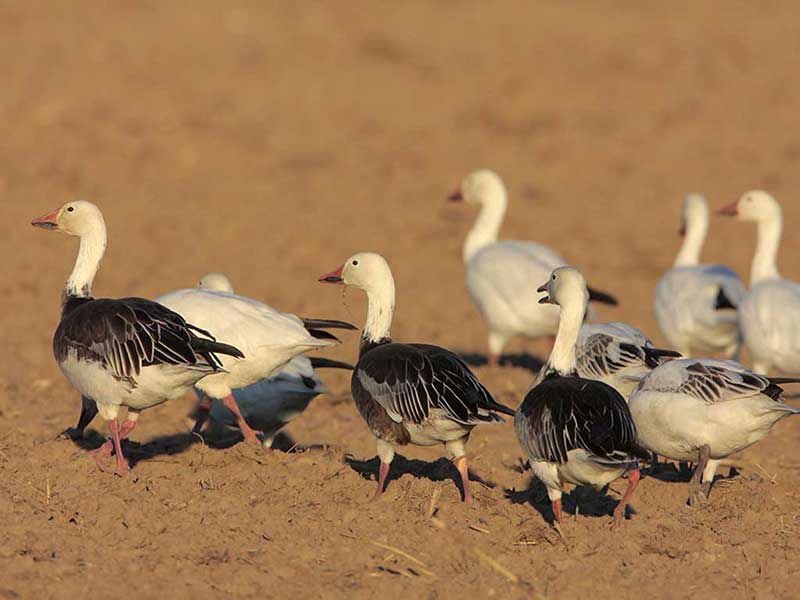
The Snow Goose is listed as Least Concern in the IUCN Red List. It has a large, increasing population and is a common bird.
Effective management at wildlife refuges and farm fields with abundant food sources have helped Snow Goose greatly increase their numbers. This is one of the few species that seems to benefit from farming and continues to grow in numbers.
Biggest threat – hunting
Technically, the biggest threat faced by the Snow Goose is hunting. After all, shooting kills more of Snow Geese than any other human activity. However, the hunting of Snow Geese is managed and does not affect their populations.
Ironically, many biologists and conservationists have called for increased hunting of Snow Goose.
Related: What do geese symbolize?
Populations of this bird species have grown so quickly that they can degrade important habitats for other, truly threatened bird species. To help counter those negative effects and balance the situation, there have been higher hunting quotas for Snow Goose.
However, even with more geese being hunted, this hasn’t done a thing to decrease the numbers of this successful species.
Facts
- As flocks of Snow Geese forage, some birds always act as lookouts for eagles and other predators. If they spot danger, they give the alarm and the entire flock may call and quickly fly into the air.
- After hatching, baby Snow Geese walk after their mother to reach better feeding areas. Sometimes, over the course of three weeks, the young birds can walk with their mother for as far as fifty miles!
- When she reaches her breeding grounds, the hen Snow Goose eats nearly all of the time (18 hours a day!). She has to eat a lot and put on weight because, while incubating her eggs, she eats very little.
- In the early 1900s, as with many other bird species, constant hunting caused great declines in populations of Snow Goose. Hunting was prohibited until their numbers had recovered in 1975.
- Although domesticated barnyard geese are often white, they are not related to the Snow Goose. Those farm birds are actually descendants of the Eurasian Graylag Goose or the Asian Swan Goose.
Similar Species
The Snow Goose is a distinctive bird, but it does resemble a few other, less common species. However, with a good look, we can separate these birds from the Snow Goose.
Ross’s Goose
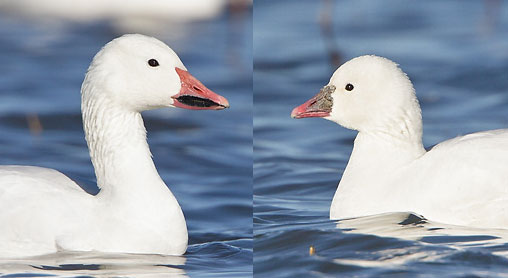
Ross’s and Snow Goose
The Ross’s Goose has very similar plumage to the Snow Goose but is much smaller. Around the same size as a Mallard, it also has a stubbier bill that lacks the dark “smile” patch found on the Snow Goose’s beak.
It also lacks the buff colors usually seen on the head of the Snow Goose. The rare dark morph Ross’s Goose has more white on its wings and less white on its neck.
Brant
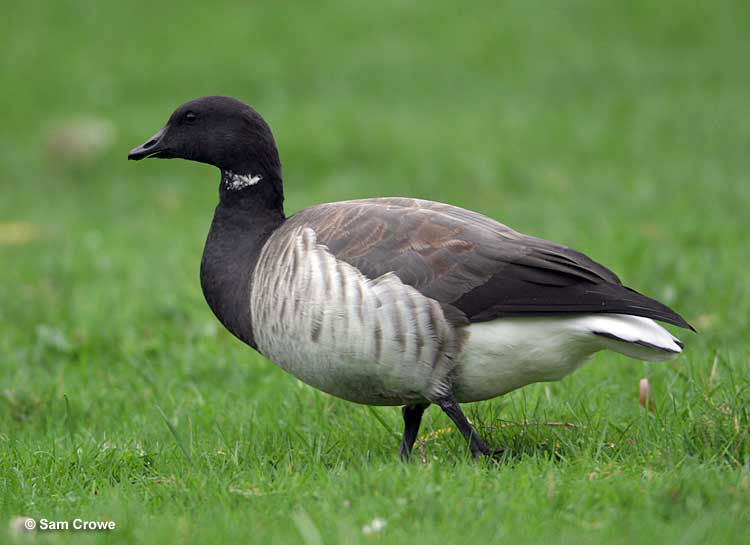
The Brant is pretty distinctive, but they are sometimes confused with young Snow Geese.
The adult Brant always has a black head and beak, some white on its neck, and a prominent white undertail. They also have dark underwings.
Emperor Goose
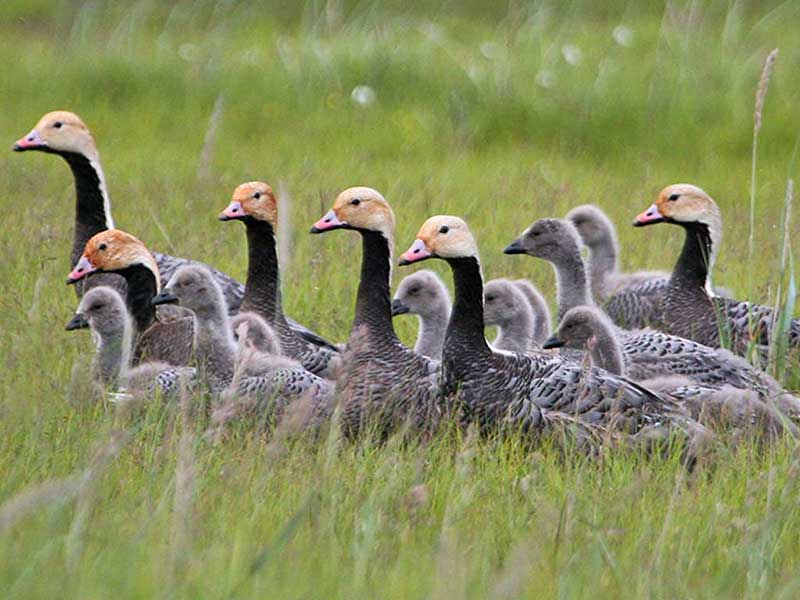
The Emperor Goose is mostly seen in Alaska but can also occur on the Pacific coast.
Adults look sort of like the dark morph Snow Goose but have a smaller, pale beak, white going down the back of their neck, and a dark rump with a white tail.
Juvenile Emperor Geese can be separated by their small beak, dark underwings, and pale spectacles.
Frequently Asked Questions
How rare is a Snow Goose?
The Snow Goose is not rare. In some places, large flocks of Snow Geese feed in farm fields and roost on nearby bodies of water.
Where are Snow Geese found?
Snow Geese are found in North America. They breed in the Arctic but winter in marshes and lakes in many parts of the western and central USA, and Mexico. They also winter in coastal waters and salt marshes in the eastern and southern USA.
Is Snow Goose the same as Canada goose?
No, the Snow Goose is not the same as a Canada Goose. It has a lot more white in its plumage and has a pinkish beak.
What’s the difference between a swan and a Snow Goose?
The difference between a swan and a Snow Goose is that swans are larger, have much longer necks, and don’t have black in their wings.


